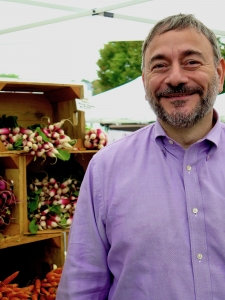Food Insecurity in America
Most of us are taught from an early age that to be healthy, we must eat healthy foods. Poor diets – those in which people consume excess fat, sugar and calories – are linked to a range of health problems including obesity, high blood pressure, diabetes and hypertension.
For some Americans, however, easy access to healthy food is not a given. An estimated 23.5 million live in food deserts, meaning that a supermarket offering a selection of healthy foods is more than one mile away in an urban area or more than 10 miles away in a rural area. Compounding the problem, over two million Americans live in food deserts and don’t have a car or public transportation, making it nearly impossible to get to a supermarket.
The Intersection of Food Insecurity and Health
Beyond those who live in food deserts, many more Americans are considered food insecure, meaning they can’t always afford sufficient food, regardless of its easy availability or nutritional value. Hunger Free America estimates that 54 million Americans are food insecure, a number that increased dramatically upon the start of the COVID pandemic.
Food insecurity has a direct impact on health. A recent study found that food insecure families have 20 percent greater health care expenditures than food-secure families, for an annual difference of $2,456. A different study found that 54 percent of older adults who are food insecure have multiple (two or more) chronic conditions, compared with 41 percent of food secure individuals.
Before the COVID pandemic, the University of Michigan National Poll on Healthy Aging surveyed a national sample of U.S. adults age 50-80 about household food insecurity. The poll found:
- 45 percent of adults who were food insecure rated their physical health as fair or poor, compared to 14 percent of those who were food secure.
- 24 percent of those who were food insecure reported fair or poor mental health, compared to five percent of those who were food secure.
- 43 percent of those who were food insecure rated their diets as being fair or poor quality compared to 20 percent of those who were food secure.
Who is Food Insecure?
“Hunger and food insecurity exist in every state in the nation – in inner cities, rural areas and even the suburbs, where the problem is growing rapidly” said Joel Berg, CEO, Hunger Free America, pointing to recent USDA data indicating that the Southeast and Southwest suffer the highest rates of food insecurity. “The mental image that most people have of who is hungry – the homeless person or panhandler on the street – is not accurate. Less than five percent of food insecure people are homeless.”
Instead, said Berg, food-insecure Americans are most often lower-income wage earners who haven’t seen a cost-of-living increase in over a decade and who often must juggle affording food with affording housing, health care, childcare and transportation.
“They may be forced to ration food, eat less frequently, buy less costly and therefore less healthy food, and even forgo food themselves to feed their children,” Berg said.
Berg noted that it may surprise some people to know that the largest number of people who are hungry and food insecure are white, “although people of color are more likely to live in poverty and suffer from food insecurity.” Households headed by single mothers, he said, have about three times the food insecurity as two-parent households.
Falling into Poverty: The Erosion of the Middle Class
Berg debunked another myth about intertwined poverty and food insecurity: that it is primarily cultural and inherited – the same people facing the problem year in and year out. Instead, he said the number of people who are sometimes poor and hungry is ten times greater than that of people who are always poor and hungry.
“Most people who suffer from food insecurity do so episodically, when they are down on their luck,” he said. “Perhaps they’ve been treading water in the middle class and their car breaks down. They can’t get to work and therefore lose their job. Or they get sick and need to take time away from work. Or their workplace shuts down or has layoffs. Suddenly, they have fallen out of the middle class and into poverty.”
Hunger Free America’s philosophy believes that ending poverty is the key to ending hunger and food insecurity.
“Until workers are paid higher wages, the government expands the federal food safety net, and there are more living wage jobs, there will continue to be hunger in America even if we produce enough food to feed all 330 million of us,” Berg said.
Hunger Free America: A Lean Organization with a Mighty Presence
Hunger Free America partners with hundreds of organizations nationwide to inspire change through a combination of advocacy and direct service designed to help people receive the assistance they need.
Hunger Free America’s AmeriCorps VISTA (Volunteers in Service to America) program works on the frontlines of hunger at partner organizations around the country. Year-long VISTA members help build the capacity of food pantries, soup kitchens and other groups by recruiting volunteers, conducting research and supporting benefits outreach.
Hunger Free America also operates the National Hunger Hotline (1-866-3-HUNGRY/1-866-348-6479) on behalf of the U.S. Department of Agriculture. The hotline directs callers from all 50 states and territories to their local SNAP (Supplemental Nutrition Assistance Program) offices, provides information about federal benefits programs, and lets callers know where they can find food immediately through a national database of food resources.
Hunger Free America also conducts advocacy at the local, state and federal levels; conducts original research on federal nutrition programs, child hunger, and the challenges facing low-income Americans; and publishes groundbreaking reports that provide data to support its concrete yet realistic solutions to poverty and hunger.
“We also operate a strategic volunteer program that connects individuals and groups with skills-based and high-impact volunteer opportunities,” Berg concluded. “It’s these opportunities that make the biggest difference in the national fight against hunger.”

















